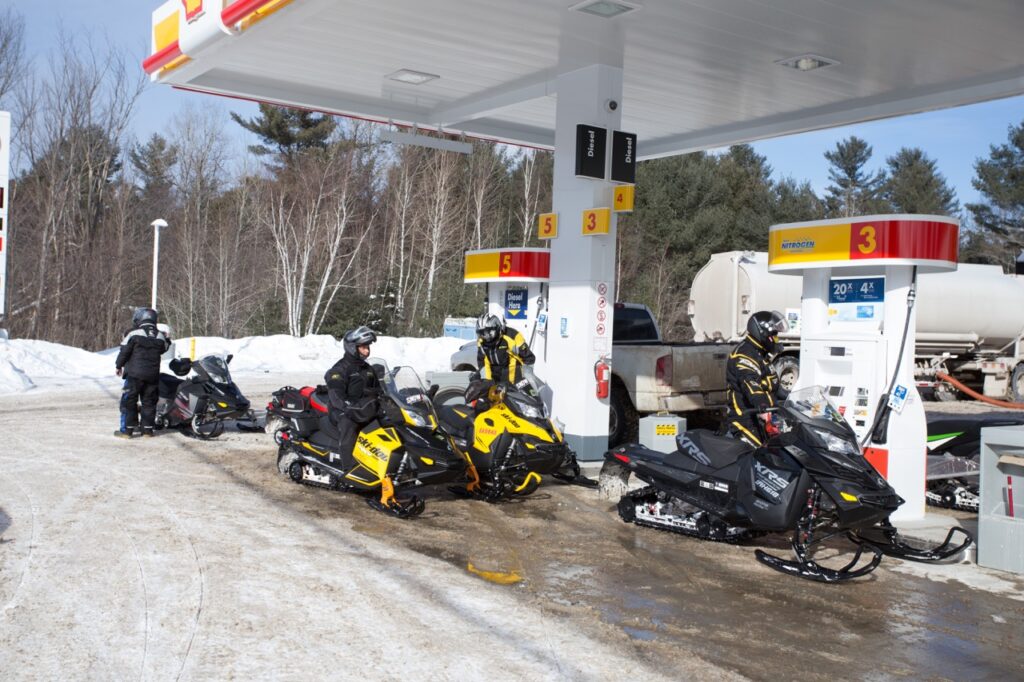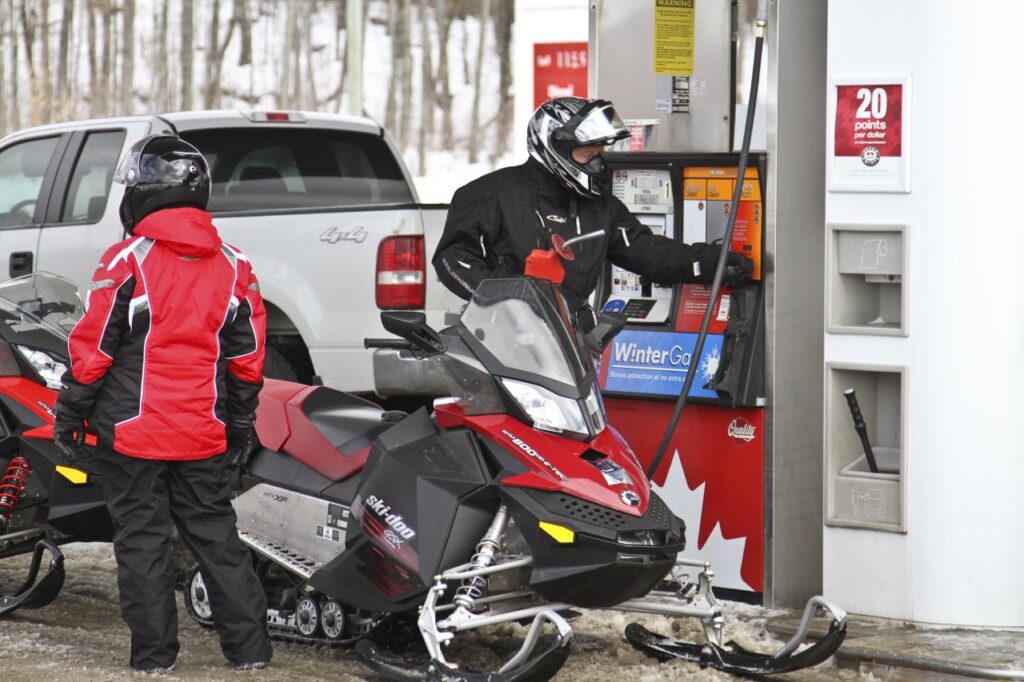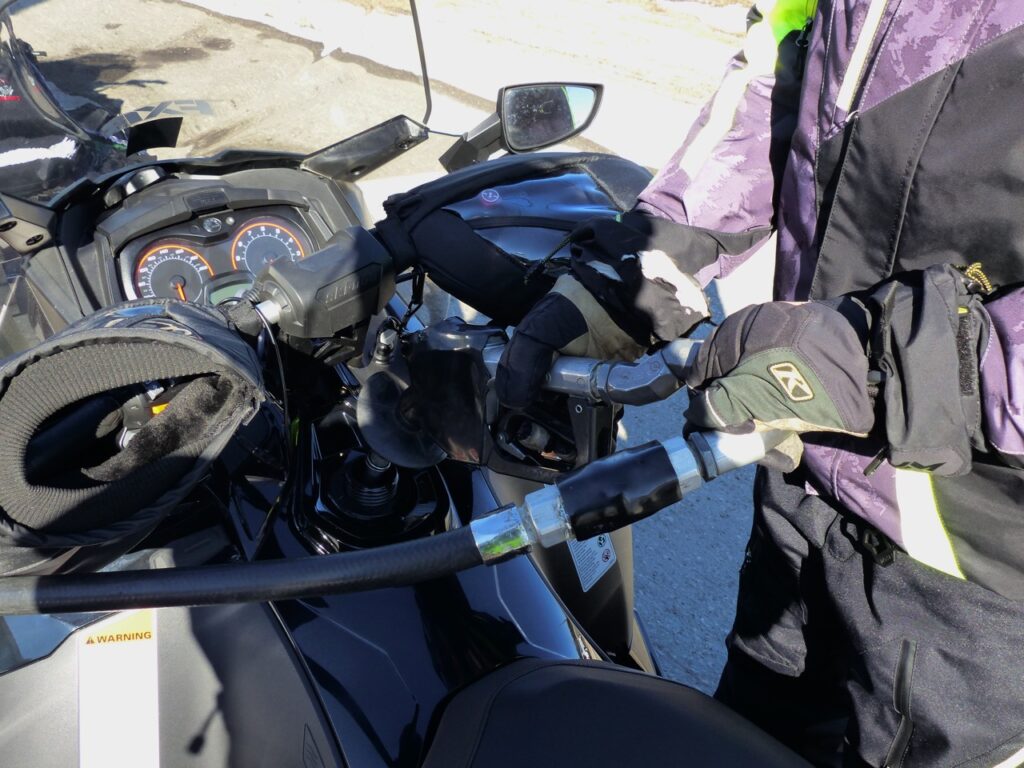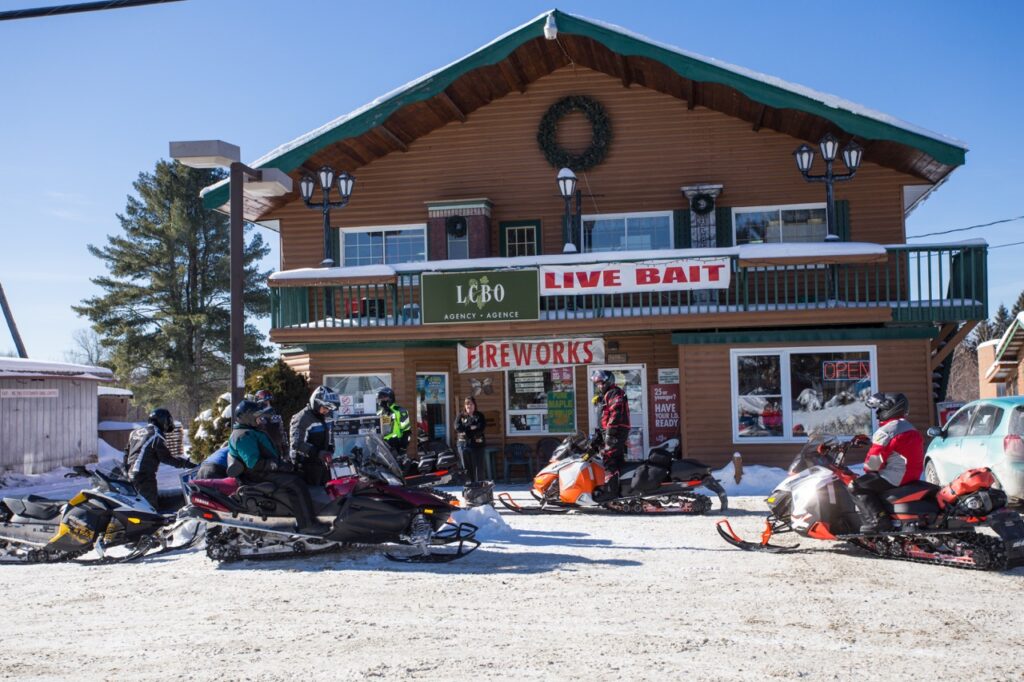Things To Know About Gassing up…
Related: Get Best Fuel Economy
Why do you need to know my top 10 snowmobile fuelling tips? Because the great equalizer among snowmobiles is that they all need gas to go. This can be especially vexing for newbies who have enough to worry about on their first rides. That’s why I recommend getting familiar with my beginners tips before setting out.
Some of today’s more advanced engines like the Rotax™ 900 ACE deliver exceptional fuel economy. Trail riding these best available technology snow machines, many snowmobilers can go all day without worrying about a fill up. Unless you’re hard on the throttle. But inevitably they still need to visit a gas station.
Whatever your sled’s fuel-range, you’re at the mercy of whichever sled in your group has the worst gas mileage. That’s because its rider will have to stop more frequently to fuel up. When this happens, remember my favourite adage about gas: “It’s always better to be looking at it than for it!” So rather than standing idly by smugly twiddling your thumbs, I advise everyone to top up at the same time, no exceptions. Then relish another opportunity to flaunt how little fuel you’ve used. Be sure to compare your gas bills and really rub it in good!
Discover My Top 10 Snowmobile Fuelling Tips
We all have to visit a gas station sooner or later. So here are my top 10 snowmobile fuelling tips about gassing up:
- Never trust your gas gauge. During your first rides on a new sled, check carefully to see how many kilometres you get on a full tank. Then set your trip distance button to zero at every fill up, so distance travelled provides you with another way of checking when you’re close to empty. Familiarizing yourself with your sled’s fuel range will also help pre-plan gas stops on tour.
- Always start with a full tank because you don’t always know how long it is to the first gas stop that’s open, has fuel or is trail accessible.
- Carbides and asphalt don’t mix well. So when riding into a gas station, look for patches of snow that will help set you up for a straight run up to the pumps. Turning on pavement can not only be a chore, but also grind the sharp edges off your carbides, so I recommend Rollerskis.
- You don’t want an attendant screaming abuse at you. So make sure never to drive over their signal hose. The first rider in should dismount and move it out of the way.
- Pump your own gas. It’s the only way to know for sure your sled is full and your gas cap is on tight. And hopefully, to avoid careless spills (although I’ve had a few when the supposedly automatic shut off on the nozzle didn’t work).
- Occasional spills are also why you should never sit on your sled’s seat while gassing up. Who needs to ride the rest of the day with a fuel soaked crotch? And don’t push down on the seat while filling to avoid overflowing the tank.
- If there are multiple sleds in your group, consider doubling up at each pump (2 sleds side by each). As each sled fills up, drive it out of the way before you pay so others can start filling.
- Don’t get your shorts in a knot if there’s no premium. Even if your manual calls for it, your engine will run fine on regular at least until the next fill up. If you’re really concerned, carry some octane booster to add to a regular fill up.
- Try not to run your tank below a third before the next fill up. This will not only avert running out. It will also help dilute bad gas if you happen to hit a station with dirt or water in their tanks. Always carry a small bottle of isopropyl-based gas line anti-freeze, just in case you do.
- If your group’s snowmobiling in an unfamiliar area, consider having at least one sled carry a caddy with extra fuel. Instal a gas rack or go for my personal preference, a LinQ System Fuel Caddy. This can go a long way to saving the day if you’re running short. If you don’t use the spare fuel, don’t let it sit in the gas caddy too long because it could go stale.
Other Important Snowmobile Fuelling Tips
Some brands or models have quirky gas tanks. Ski-Doo riders on any REV chassis or variation thereof quickly learn the trick. You can squeeze a few litres more in at every fill up by “burping” your sled. This involves almost filling the tank and then pushing down and up on the back end several times to release any trapped air, before topping up – kind of like burping a baby! This extra few litres can be the difference between making the next station or not.
Despite getting better gas mileage today than ever before, my snowmobile fuelling tips include starting to look for gas when the tank’s about half empty. It’s also hard to shake another adage that’s proved its value to me over the years: “Never pass gas!” This is especially true now that so many mom & pop stations are being squeezed out by the major gas companies or closing due to retirement. So the station that used to be there, may not be anymore.
Besides, while riding any place unfamiliar, you never know where the next station is. And you can’t count on signs to find gas. It seems that more often than not, I see signs 10 or 15 km away, but none close to show exactly how to get there. In many rural areas, you also don’t know for sure whether that next station will be open on that day. Or by the time you arrive. Or has run out of fuel and awaits the next delivery. So why take the chance?
Another of my snowmobile fuel tips is that stopping for gas provides a good rest break. It also is an opportunity to use the bathroom, to warm up (both much appreciated by family members) or to grab a drink or snack. You can also use gas stops to double check your route. And do a quick visual once-over of your sled, just to make sure nothing appears out of whack. So while I love the peace of mind of knowing I can ride all day if necessary with my Rotax 900 ACE engine, gas stops are still very much a part of my trail riding experience.
Like This Post? Follow Me on Facebook
The tips and advice in this blog are the opinions of the author, may not work in every situation and are intended only for the convenience and interest of the reader, who has the personal responsibility to confirm the validity, accuracy and relevancy of this information prior to putting it to their own use.





